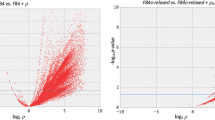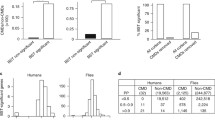Summary
The numbers and local sequence environments of the two types of substitution mutation plus additions and deletions have been obtained directly in this study from differences between a large number of extant primate gene and pseudogene sequences. A total of 3786 mutations were scored in regions where similarities between pseudogene and corresponding gene sequences is ≥ 85%, comprising ∼30% of the pseudogene database of 80,584 bp. The pattern of mutations obtained in this fashion is almost identical to that obtained by Li et al. (1984) using a slightly different, more direct approach and with a smaller database. When mutations were scored, the neighbor pairs on the 5′ and 3′ sides were also noted, leading to a large 16 × 12 matrix of transitions and transversions. Biases of varying magnitude are found in the rates of substitution of the same base pair in different local sequence environments. The overall order for the effect of the 5′ neighbor on the rates of substitution mutation of a pyrimidine is A > C ≫ T > G, and G > A > T > C for the 3′ neighbor; where these results represent the average of substitution rates for the complement purine with complement neighbors of bases ordered above. The order for the 3′ neighbor is essentially the same for the two transitions and most of the four transversions as well; however, the order for the 5′ neighbor is more variable. The overall rate for the C · G → T · A transition is not unusual, however the presence of a 3′ neighboring G · C pair boosts the rate substantially, presumably due to specific cytosine methylation of the CG doublet in primate DNAs. The rate of the T · A → C · G transition is also well above average when the 3′ neighbor is an A · T, and to a lesser extent a G · C, pair. The latter bias is typical in that it reflects the association of alternating pyrimidine-purine sequences with increasing mutation rates. The substitution of the pyrimidine in a 5′ purine-pyrimi-dine-purine3′ sequence generally occurs much faster than in a pyrimidine tract and points to the local conformation as a major determining factor of the substitution rate. An apparent inverse relationship is found between starting and product doublet frequencies of base pairs undergoing mutations with specific 3′ neighbors, indicating that differences in intrinsic substitution rates of base pairs with specific neighbors are a key factor in producing the familiar biases of nearest-neighbor frequencies.
Similar content being viewed by others
References
Benzer S (1961) On the topography of the genetic fine structure. Proc Natl Acad Sci USA 47:403–415
Bevington PR (1969) Data reduction and error analysis for the physical sciences. McGraw-Hill, New York, chapters 1, 5, pp 1–10, 66–91
Bird A (1986) CpG-rich islands and the function of DNA methylation. Nature 321:209–213
Blake RD, Hinds PW, Earley S, Hillyard AL, Day GR (1986) Evolution and functional significance of the bias in codon usage. In: Sarma RH, Sarma MH (eds) Biomolecular stereodynamics IV. Proceedings of the Fourth Conversation in the Discipline Biomolecular Stereodynamics. Adenine Press, Albany NY, pp 271–286
Brown WM, Prager EM, Wang A, Wilson AC (1982) Mitochondrial DNA sequences of primates: tempo and mode of evolution. J Mol Evol 18:225–239
Calladine CR, Drew HR (1986) Principles of sequence-dependent flexure of DNA. J Mol Biol 192:907–918
Carbonnaux, C, Fazakerley GV, Sowers LC (1990) An NMR structural study of deaminated base pairs in DNA. Nucleic Acids Res 18:4075–4081
Coll M, Frederick CA, Wang AH-J, Rich A (1987) A bifurcated hydrogen-bonded conformation in the d(A · T) base pairs of the DNA dodecamer d(CGCAAATTTGCG) and its complex with distamycin. Proc Natl Acad Sci USA 84:8385–8389
Cupples CG, Cabrera M, Cruz C, Miller JH (1990) A set of lacZ mutations in Escherichia coli that allow rapid detection of specific frameshift mutations. Genetics 125:275–280
Ehrlich M, Zhang X-Y, Inamdar NM (1990) Spontaneous deamination of cytosine and 5-methylcytosine residues in DNA and replacement of 5-methylcytosine residues with cytosine residues. Mut Res 238:277–286
Fersht AR, Knill-Jones JW, Tsui WC (1982) Kinetic basis of spontaneous mutation. Misinsertion frequencies, proofreading specificities and cost of proofreading by DNA polymerases of E. coli. J Mol Biol 156:37–51
Fitch WM (1983) Random sequences. J Mol Biol 163:171–176
Fix DF, Koehler DR, Glickman BW (1990) Uracil-DNA glycosylase activity affects the mutagenicity of ethylmethanesulfonate: evidence for an alternative pathway of alkylation mutagenesis. Mut Res 244:1115–1121
Frederico LA, Kunkel TA, Shaw BR (1990) A sensitive genetic assay for the detection of rate constants and the activation energy. Biochemistry 29:2532–2537
Glickman BW, Fix DF, Yatagai F, Burns PA, Schaaper RM (1986) Mechanisms of spontaneous mutagenesis: clues from mutational specificity. In: Simic MG, Grossman L, Upton AC (eds) Mechanisms of DNA damage and repair. Plenum, New York, pp 425–437
Gojobori T, Li W-H, Graur D (1982) Patterns of nucleotide substitution in pseudogenes and functional genes. J Mol Evol 18:360–369
Hinds PW, Blake RD (1984) Degrees of divergence in the E. coli genome from the correlation between dinucleotide, trinucleotide and codon frequencies. J Biomol Struct Dyn 2: 101–118
Hunter WN, Brown T, Anand NN, Kennard O (1986) Structure of an adenine-cytosine base pair in DNA and its implications for mismatch repair. Nature 320:552–555
Jones M, Wagner R, Radman M (1987) Repair of a mismatch is influenced by the base composition of the surrounding nucleotide sequence. Genetics 115:605–610
Josse J, Kaiser AD, Kornberg A (1961) Enzymatic synthesis of deoxyribonucleic acid. VIII. Frequencies of nearest neighbor base sequences in deoxyribonucleic acid. J Biol Chem 236: 864–871
Jukes TH, Cantor CR (1969) Evolution of protein molecules. In: Munro HN (ed) Mammalian protein metabolism, vol 3. Academic Press, New York, pp 21–132
Kennard O (1985) Structural studies of DNA fragments: the G·T wobble base pair in A, B and Z DNA; the G·A base pair in B-DNA. J Biomol Struct Dyn 3:205–226
Koch RE (1971) The influence of neighboring base pairs upon base-pair substitution mutation rates. Proc Natl Acad Sci USA 68:773–776
Koop BF, Goodman M, Xu P, Chan P, Slightom JL (1986) Primate η-globin DNA sequences and man's place among the great apes. Nature 319:234–238
Li W-H (1983) Evolution of duplicate genes and pseudogenes. In: Nei M, Koehn RK (eds) Evolution of genes and proteins. Sinauer, Sunderland MA, pp 14–37
Li W-H, Wu C-I, Luo C-C (1984) Nonrandomness of point mutation as reflected in nucleotide substitutions in pseudogenes and its evolutionary implications. J Mol Evol 21:58–71
Li W-H, Luo C-C, Wu C-I (1985) Evolution of DNA sequences. In: MacIntyre RJ (ed) Molecular evolutionary genetics. Plenum, New York, pp 1–94
Lindahl T (1982) DNA repair enzymes. Annu Rev Biochem 51:61–87
Lipman DJ, Pearson WR (1985) Rapid and sensitive protein similarity searches. Science 227:1435–1441
Lu A-L, Chang D-Y (1988) Repair of single base-pair transversion mismatches of Escherichia coli in vitro: correction of certain A/G mismatches is dependent of dam methylation and host mutHLS gene functions. Genetics 118:593–600
Mendelman LV, Boosalis MS, Petruska J, Goodman MF (1989) Nearest neighbor influences on DNA polymerase insertion fidelity. J Biol Chem 264:14415–14423
Miller JH, Low KB (1984) Specificity of mutagenesis resulting from the induction of the SOS system in the absence of mutagenic treatment. Cell 37:675–682
Modrich P (1987) DNA mismatch correction. Annu Rev Biochem 56:435–466
Needleman SB, Wunsch CD (1970) A general method applicable to the search for similarities in the amino acid sequence of two proteins. J Mol Biol 48:443–453
Nelson HCM, Finch JT, Luisi BF, Klug A (1987) The structure of an oligo(dA)·oligo(dT) tract and its biological implications. Nature 330:221–226
Radman M, Wagner R (1986) Mismatch repair in E. coli. Annu Rev Genet 20:523–538
Razin A, Riggs AD (1980) DNA methylation and gene function. Science 210:604–610
Russell GJ, McGeoch DJ, Elton RA, Subak-Sharp JH (1973) Doublet frequency analysis of bacterial DNAs. J Mol Evol 2: 277–292
Setlow P (1976) In: Fasman GD (ed) Handbook of biochemistry and molecular biology, 3rd ed, vol II. CRC Press, Cleveland OH
Shakked Z, Rabinovich D (1986) The effect of the base sequence on the fine structure of the double helix. Prog Biophys Molec Biol 47:159–195
Shibata M, Zielinski TJ, Rein R (1991) Molecular mechanism of base substitution mutations: from hydrogen bonding to molecular dynamics. In: Beveridge DL, Lavery R (eds) Theoretical biochemistry and molecular biophysics, vol 1: DNA. Adenine Press, Schenectady, NY, pp 309–319
Singer B, Grunberger D (1983) Molecular biology of mutagens and carcinogens. Plenum, New York, chapter 3, pp 15–44
Topal MD, Fresco JR (1976) Complementary base pairing and the origin of substitution mutations. Nature 263:285–289
Topal MD, DiGuiseppi SR, Sinha N (1980) Molecular basis for substitution mutations. J Biol Chem 255:11717–11724
Tung C-S, Harvey SC (1986) Base sequence, local helix structure, and macroscopic curvature of A-DNA and B-DNA. J Biol Chem 261:3700–3709
Wiebauer K, Jiricny J (1990) Mismatch-specific thymine DNA-glycosylase and DNA polymerase β mediate the correction of G · T mispairs in nuclear extracts from human cells. Proc Natl Acad Sci USA 87:5842–5845
Wilbur WJ, Lipman DJ (1983) Rapid similarity searches of nucleic acid and protein data banks. Proc Natl Acad Sci USA 80:726–730
Wu C-I, Maeda N (1987) Inequality in mutation rates of the two strands of DNA. Nature 327:169–170
Author information
Authors and Affiliations
Additional information
Offprint requests to: R. D. Blake
Rights and permissions
About this article
Cite this article
Blake, R.D., Hess, S.T. & Nicholson-Tuell, J. The influence of nearest neighbors on the rate and pattern of spontaneous point mutations. J Mol Evol 34, 189–200 (1992). https://doi.org/10.1007/BF00162968
Received:
Revised:
Issue Date:
DOI: https://doi.org/10.1007/BF00162968




